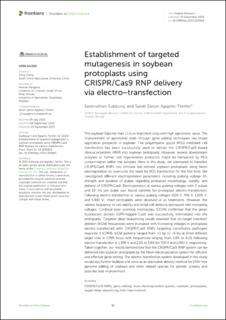| dc.contributor.author | Subburaj, Saminathan | |
| dc.contributor.author | Agapito-Tenfen, Sarah Zanon | |
| dc.date.accessioned | 2023-11-24T11:56:46Z | |
| dc.date.available | 2023-11-24T11:56:46Z | |
| dc.date.created | 2023-10-03T10:44:57Z | |
| dc.date.issued | 2023 | |
| dc.identifier.citation | Frontiers in Plant Science. 2023, 14 . | en_US |
| dc.identifier.issn | 1664-462X | |
| dc.identifier.uri | https://hdl.handle.net/11250/3104537 | |
| dc.description.abstract | The soybean (Glycine max L.) is an important crop with high agronomic value. The improvement of agronomic traits through gene editing techniques has broad application prospects in soybean. The polyethylene glycol (PEG)-mediated cell transfection has been successfully used to deliver the CRISPR/Cas9-based ribonucleoprotein (RNP) into soybean protoplasts. However, several downstream analyses or further cell regeneration protocols might be hampered by PEG contamination within the samples. Here in this study, we attempted to transfect CRISPR/Cas9 RNPs into trifoliate leaf-derived soybean protoplasts using Neon electroporation to overcome the need for PEG transfection for the first time. We investigated different electroporation parameters including pulsing voltage (V), strength and duration of pulses regarding protoplast morphology, viability, and delivery of CRISPR/Cas9. Electroporation at various pulsing voltages with 3 pulses and 10 ms per pulse was found optimal for protoplast electro-transfection. Following electro-transfection at various pulsing voltages (500 V, 700 V, 1,000 V, and 1,300 V), intact protoplasts were observed at all treatments. However, the relative frequency of cell viability and initial cell divisions decreased with increasing voltages. Confocal laser scanning microscopy (CLSM) confirmed that the green fluorescent protein (GFP)-tagged Cas9 was successfully internalized into the protoplasts. Targeted deep sequencing results revealed that on-target insertion/deletion (InDel) frequencies were increased with increasing voltages in protoplasts electro-transfected with CRISPR/Cas9 RNPs targeting constitutive pathogen response 5 (CPR5). InDel patterns ranged from +1 bp to −6 bp at three different target sites in CPR5 locus with frequencies ranging from 3.8% to 8.1% following electro-transfection at 1,300 V and 2.1% to 3.8% for 700 V and 1,000 V, respectively. Taken together, our results demonstrate that the CRISPR/Cas9 RNP system can be delivered into soybean protoplasts by the Neon electroporation system for efficient and effective gene editing. The electro-transfection system developed in this study would also further facilitate and serve as an alternative delivery method for DNA-free genome editing of soybean and other related species for genetic screens and potential trait improvement. | en_US |
| dc.language.iso | eng | en_US |
| dc.rights | Navngivelse 4.0 Internasjonal | * |
| dc.rights.uri | http://creativecommons.org/licenses/by/4.0/deed.no | * |
| dc.title | Establishment of targeted mutagenesis in soybean protoplasts using CRISPR/Cas9 RNP delivery via electro−transfection | en_US |
| dc.title.alternative | Establishment of targeted mutagenesis in soybean protoplasts using CRISPR/Cas9 RNP delivery via electro−transfection | en_US |
| dc.type | Peer reviewed | en_US |
| dc.type | Journal article | en_US |
| dc.rights.holder | © 2023 Subburaj and Agapito-Tenfen. | en_US |
| dc.description.version | publishedVersion | en_US |
| cristin.ispublished | true | |
| cristin.fulltext | original | |
| cristin.qualitycode | 2 | |
| dc.identifier.doi | 10.3389/fpls.2023.1255819 | |
| dc.identifier.cristin | 2181238 | |
| dc.source.journal | Frontiers in Plant Science | en_US |
| dc.source.volume | 14 | en_US |
| dc.source.pagenumber | 11 | en_US |

